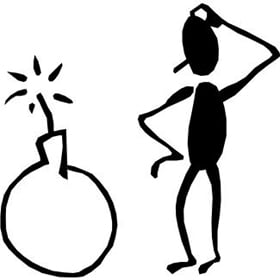The Bearer of Bad News on Iran
The latest IAEA report on Iran contains a mountain of bad news. Does the Obama administration have a plan for The Day After?
The International Atomic Energy Agency (IAEA) on Monday issued its quarterly report on Iran’s nuclear program, and it contained a grain of good news, but a ton of bad news.
 As there has been little good news on Iran’s nuclear activities the good news deserves some attention. And what is it? During the reign of two of the IAEA’s director generals, Hans Blix and Mohammed ElBaradei, while Iran’s secret nuclear program was born and grew, the operating paradigm of the IAEA was to mute its criticism of Iran in order to not frighten Iran into non-cooperation with the IAEA and as Mohammed ElBaradei is reported to have said not to provide a justification for military action against Iran’s nuclear facilities.
As there has been little good news on Iran’s nuclear activities the good news deserves some attention. And what is it? During the reign of two of the IAEA’s director generals, Hans Blix and Mohammed ElBaradei, while Iran’s secret nuclear program was born and grew, the operating paradigm of the IAEA was to mute its criticism of Iran in order to not frighten Iran into non-cooperation with the IAEA and as Mohammed ElBaradei is reported to have said not to provide a justification for military action against Iran’s nuclear facilities.
The IAEA has a new Director General, Yukiya Amano, and this latest report represents a new direction in candor from Vienna. Without mincing words or any wrapping in diplomatic honey, the report clearly says Iran continues to be non-responsive to IAEA demands for answers and access that would allow inspectors to determine the actual state of Iran’s nuclear activities such as its centrifuge manufacturing, uranium, mining and milling and various nuclear experiments. Iran has in the last few months, according to the report, broken seals that the inspectors had earlier applied to Iran’s stock of low enriched uranium, thus leaving unknown whether any of the material had been diverted; refused to provide details or access to announced new uranium enrichment facilities, a heavy water production plant and a new reactor that are in varying stages of construction or planning; and barred two of the IAEA’s most experienced inspectors on the grounds that they had made “false and wrong statements” concerning Iran’s nuclear activities. In a very surprising manner for the IAEA, the report not only condemned Iran’s barring of these two inspectors, but went back to Iran's 2007 banning of two other inspectors on similar grounds. At the time, then-Director General ElBaradei had refused to protest Iran’s actions and defend his own inspectors. This public calling out of Iran for asserting the right to pick and choose who inspects it is both a change in IAEA policy and a rebuke to its previous director general.
That is about the end of the good news from this latest report. The facts on the ground concerning Iran’s nuclear activities continue to grow worse. As the report says, Iran continues its program of producing low enriched uranium; is producing uranium enriched to 20 percent levels—well above the 5 percent levels that nuclear power plants use and readily enriched to the higher level needed for nuclear weapons; continues to manufacture more centrifuges; refuses to detail how it is obtaining the natural uranium it feeds its enrichment facilities; has work underway on a plutonium production reactor; and will not discuss its work on its missile delivery system.
The breaking of the seals on the previously produced low enriched uranium, in and of itself, mean more work for the inspectors as they will have to re-verify the amounts and determine whether any diversion of this material has occurred. But far more importantly, it represents an easy path for Iran to divert inspection attention and effort away from other activities that may be much more troublesome. Inspection manpower and time in Iran is not infinite. Inspectors cannot refuse to re-verify containers of uranium that have broken seals, and Iran knows this. The question is, “What will the inspectors not be doing while reconfirming the contents of these containers?” Iran probably also knows this. And by the way, the report notes no slow down in any of Iran’s nuclear activities in response to the latest round of UN and bilateral economic sanctions.
Probably the worst news, and it goes well beyond Iran, is Iran’s success in asserting its right to choose who inspects it. Iran is legally correct under the rules of the IAEA and the Nuclear Non-Proliferation Treaty in that it has this right and that it is not the first to assert it. Its neighbor Iraq asserted this right throughout the 1980s as it built its nuclear weapons program. This loophole in the nonproliferation regime has been well known, but continues without any effective effort to close it off. Any inspection regime, whether it be offshore drilling, eggs or pharmaceutical drugs, requires an unfettered inspectorate, not a “send me the inspectors I will approve of” attitude. As the Gulf of Mexico, our breakfast table and Iran show, this is a lesson that we refuse to learn.
Finally, the Obama administration needs to begin to seriously contemplate what it will do on the Day After. Day After what? The Day After it is no longer possible to maintain that economic sanctions alone will change Iran’s nuclear course. The Day After Iran rips the veil and declares that it will pursue the enrichment of uranium and the production of plutonium free of any IAEA inspections or restrictions. The Day After Iran announces it has deployed missiles capable of carrying “the world’s most destructive weapons.” The Day After Iran conducts a nuclear weapons test. Any and all of these alternatives seem possible and certainly more likely than that the administration’s clinging to economic sanctions will bring about a change in Iran’s current course to nuclear weapons capability.
